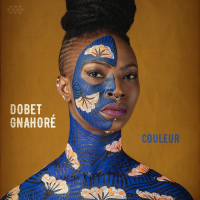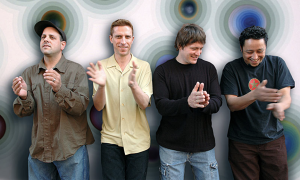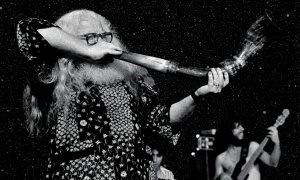Home » Jazz Articles » From the Inside Out » Rediscovery and Re-Creation, and an NYC Farewell
Rediscovery and Re-Creation, and an NYC Farewell

Courtesy Brasuka
 Greg Abate
Greg AbateMagic Dance: The Music of Kenny Barron
Whaling City Sound
2021
Musicians will sometimes honor another musician who influenced their lives or work with a tribute or memorial recording after that influential musician has passed on. There's an abundance of first-rate music on the double-disc Magic Dance: The Music of Kenny Barron. But the best thing about is that the leader, flutist and saxophonist Greg Abate, convinced Kenny Barron to fill its piano chair. "Kenny was kind enough to provide me with music for a range of his tunes, some more well-known than others," explains Abate, who first met the pianist in 1996. "The only difficult part was choosing which ones to record."
Abate enlisted bassist Dezron Douglas and drummer Johnathan Blake to provide the rhythms, and engaged Rudy Van Gelder Studio for the recording. Abate's arrangements and dexterity on flute and alto, tenor, baritone, and soprano saxophones profoundly complement the majesty and gracefulness of Barron's compositions.
The results are consistently brilliant. On disc one, harmonized alto and tenor saxophones lend a classic be-bop luster to "Golden Lotus," tinged with blue notes from jazz and the Orient. Barron leans into Latin jazz underneath Abate's rollicking solos, which sometimes sound like Sonny Rollins touring "St. Thomas," and pours plenty of power and soul into his own solo. "Water Lily" also pours out eastern colors and sounds, especially when Abate plays flute. "Water Lily" sweetly echoes Barron's work with multi-instrumentalist Yusef Lateef on warm yet adventurous recordings such as Hush 'N' Thunder (Atlantic, 1972), which Barron primarily composed. Disc one ends with "Bud Like," a brain-scrambling bop melody and evidently Barron's paean to piano legend Bud Powell. The rhythm section shifts once more into Latin jazz for the first part of Barron's rolling solo, then the pianist dives in and joins them, building up a Horace Silver-type of "Spanish tinge" in various shades of blue.
Disc two opens in the crosscurrents of "Lemuria," blown like a hot dry wind by Abate's harmonizing alto and tenor saxophones and anchored by powerhouse Barron, whose churning left and right hands convene like an army on the march. Blake's drumrolls serve as the runway for "Voyage" to soar into swinging ensemble jazz, with the pianist and rhythm section sounding so much larger than only three musicians behind the leader's hard-rocking multitracked horns. The closing "And Then Again" keeps this hot jazz burning, with Abate honoring the flame of Charlie Parker's alto and Barron transforming his solo into a "Bud Like" furnace of dense, intense musical heat. It's cool hearing Abate duel with himself with overdubbed alto and baritone, while drummer Blake and bassist Douglas keep the tempo hot.
Greg Abate's tribute to pianist Kenny Barron, played with pianist Kenny Barron, is truly a magic dance.
 Charlie Ballantine
Charlie BallantineReflections/Introspection: The Music of Thelonious Monk
Self-Produced
2021
Reflections/Introspection... follows-up guitarist Charlie Ballentine's Life is Brief: The Music of Bob Dylan, the guitarist's tribute to another (and very different type of) iconoclastic modern composer and one of the best albums of 2018. He absolutely bounces through this double-LP (one trio, one quartet) on a merry joyride through the compositions of "the onliest Monk."
"Monk has such an incredible catalogue that one of the big challenges we faced was what songs to choose and also what instrumentation to use," explains Ballentine. "There is just so much timeless material from Monk's trio work as well as his quartets with legendary saxophonists like 'Trane, Johnny Griffin, and Charlie Rouse that we decided to expand the project to a double LP with one LP being trio and the other LP being quartet."
There's no piano on this Monk tribute but even if there was, Ballentine's playing would make it irrelevant. He makes it sound just as easy if not easier to bend and twist and fracture notes—which Monk enjoyed so much—on guitar.
Ballentine first dives into the guitar trio setting with bassist Chris Parker and drummer Cassius Goens. Drums settle into the rhythm of "Bemsha Swing" just as the guitar begins to find its melody, and as Ballentine pulls Middle Eastern tinges into his improvisation, their "Swing" sounds like bolero and a gutbucket guitar-organ soul-jazz combo. (Also dig the toothsome seven-minute alternate take.) A cloud of jumbled electronic guitar sound floats into the opening of "Ugly Beauty," leading Ballantine to pick the melody out of the air as if by random guitar magic and meander through both the "ugly" and the "beautiful" sounds of his instrument. He nuzzles an affectionate solo version of "Pannonica" to end this trio set.
Saxophonist Amanda Gardier turns the trio into a quartet for the second set. Ballentine's guitar rings out the opening of "Brilliant Corners" with a perfectly odd, country twang. Saxophone and guitar play in unison before branching into their solos, where Gardier's hefty yet light sense of swing both stutters and sways into echoes of Monk's longtime foil, Rouse. Parker kicks in the door to "Green Chimneys" with swivel-hipped New Orleans drums, popping off like firecrackers while Ballentine chops out blue chords as if hewing them from solid rock: the sound of Wes Montgomery via James Blood Ulmer.
Monk would probably like Reflections/Introspection..., which would be high praise for music played in his honor.
 Brasuka
BrasukaA Vida Com Paixão
Outside In Music
2021
Brasuka first came together as a side project, led by keyboardist and vocalist Rosana Eckert and percussionist Ricardo Bozas , from out of a Sergio Mendes tribute band. You can still hear these roots in this full-length debut. But you can also hear where and how Brasuka's sound branches out into different styles and frameworks and yet retain the warm, inviting and bright sound of their original inspiration.
Eckert's lead vocal on the title track to A Vida Com Paixão ("A Life With Passion") glows with soft yet intense romance, so much like Janis Hansen's in the original Brasil '66 ("The Look of Love" is a great example), a description offered as both comparison and compliment. Piano and keyboard parts often seem to direct the music other instruments play, just like Mendes seemed to conduct Brasil '66 through his own keyboards. Brasuka's frantic raveup through "Sgt. Pepper's Lonely Hearts Club Band" to close this show places the period at the end of all this 1960s afterglow.
"Road to Hermeto" documents the first tune Brasuka composed together. Eckert's voice floats and whispers like clouds of Flora Purim through a bright, jumping melody inspired by groundbreaking Brazilian composer Hermeto Pascoal, while chattering percussion and rhythmic piano keep everything moving in time. Composed and sung by keyboardist Denny Robinson , "La Higuera" extends another lovely musical invitation written in piano and flute to linger in a groove as sunny and warm as a summer day and culminates in a spirited singalong over thick, pulsating percussion.
The title track bounces Portuguese vocals atop Caribbean reggae with clattering drums, and ventures through a pinwheeling electric guitar solo before winding up in another fun singalong.
But the opening "Samba Jiji" is the prototype for this set and the best place from which to start. It immediately showcases Eckert's vocal and Bozas' percussion, both steered by strong piano lines into a luscious musical ride as powerful yet smooth as a luxury vehicle. Its closing verses explode into a joyous vocal chorus shot through with saxophone improvisation, police whistles, and other party sounds. "This song best represents the band. It's based on the Partido Alto rhythm which is a different kind of samba that is modern and funky," Eckert explains. "It's danceable, and like many of our songs, has a big sing-along at the end."
"We're trying to create happy music. We want to tell stories and get people to dance. We want to bring people together."
 Dominican Jazz Project
Dominican Jazz ProjectDesde Lejos
Summit Records
2021
DJP's primary composer and keyboard player Stephen Anderson has worked to get the DJP back into the studio after their 2016 Dominican Jazz Project (Summit Records) debut received so much critical and popular acclaim. The 2020 pandemic and attendant lockdowns delayed but did not cancel this follow-up, which the band recorded Desde Lejos—"From Afar."
Primarily composed by Anderson in his COVID "compositional woodshed" (his term for lockdown) plus two ballads by singer-guitarist Carlos Luis, Desde Lejos remains true to the folkloric Dominican and swinging ensemble jazz aspects in this band's name, resulting in powerful music played so collaboratively and communicatively that you'd never guess it was recorded "from afar" (remotely) from North and South Carolina, Cuba, Puerto Rico and the Dominican Republic.
The unaccompanied sax introduction to the leadoff "Fuera De La Oscuridad" opens a world of inventive and colorful music that emerges "Out of the Darkness" of silence. Anderson's first solo unleashes a true piano monster and bursts like a great white shark through the churning bass, drum and percussion rhythms. Just as saxophonist Sandy Gabriel starts cooking, drummer Guy Frometa and percussionist David Almengod drop the bottom completely out then sweep it back in, creating powerful waves of irresistible Latin rhythm, and "Fuera De La Oscuridad" ends like a fireworks finale in an explosion of joyful, multicolored sound.
"Siempre Adelante" ("Ever Moving Forward") features trumpeter Mayquel Gonzalez and was written by late DJP bassist Jeffry Eckles, who suddenly passed during preparations for this recording. It opens as the type of melody that seems to constantly move ahead, as if in search of itself, on a Latin shuffle. But this shuffle quickly rips into torrid Latin funk, with González and Gabriel igniting trumpet and sax solos that leap into each new bright note. It all crests into a piano/drum/percussion section where all three musicians share the melody between them. ("I composed the tune 'Sin Palabras' ['No Words'] in honor of Jeffry out of pure emotion in the days following the news of his death," Anderson recalls.)
"Pero Aún No Es El Fin" ("But the End is Not Yet") captures the most free-wheeling eight minutes of musical "wow" on this set. Soloists Anderson, Gonzalez, and Gabriel dust the top with staccato flurries of sparkling notes that twist and turn back on themselves and yet simultaneously reach farther and farther out, while drummer Frómeta often sounds like Stewart Copeland or even Bill Bruford, seeming to play all around the beat but while keeping the music in order and moving forward too.
"Pero Aún No Es El Fin" rings out a message of hope and promise particularly fit to fight against the discouraging thoughts of pandemics and lockdowns.
 Dobet Gnahoré
Dobet GnahoréCouleur
Cumbancha
2021
The personal life of singer-songwriter Dobet Gnahoré can be seen as a journey back to its source, which started in her native Côte d'Ivoire (Ivory Coast), wound and lingered through an adopted homeland (France), and then returned, in part to reconnect with family and creative spirits, to the Ivory Coast.
Gnahoré's musical life has been a journey, too. Her band Ano Neko received a Best Newcomer nomination at the 2006 World Music Awards for its recorded debut. "Pearls," her collaboration with w/American singer-songwriter India Arie, claimed the Best Urban/Alternative Performance GRAMMY Award for 2010.
Gnahoré stuffs Couleur, her sixth full-length recording, full to its bursting seams with supercharged dancefloor sounds and shades. You hear in the opening "Désert" how the connected, collective spirit of African music—with very few solo parts, but each part locking into the others—influenced 1980s/1990s American and European dance/club music, especially through artists such as Grace Jones. "Désert" sounds simpler than it is, with an edgy spirit of ferocity, pride and defiance.
Even so, Gnahoré the songwriter rarely seems to challenge Gnahoré the singer on Couleur. Its production polish seems to turn to impenetrable steel on some pieces ("Zaliguéhi," "Mon Époque"), leaving the singer little more to do than toast and rap in staccato.
Songs that allow for something different prove refreshing. In "Jalouse," her double-tracked harmonized vocal shines sunny and warm, providing cover for music that seems to blossom under and around it; when her voice floats and lingers in her upper register, it leaves traces of Sade like melancholy clouds behind.
"Rédemption" sounds written more for listening than for dancing, with a flute melody and violin counterpoint/response to the lead vocal. Its tick-tock ending rocks the music to sleep like a baby in the warm comfort and security of its mother's arms, a beautiful incongruity.
The multi-cultured, multicolored "Woman" is Couleur's crowning glory, pumping out a dancefloor rhythm as strong, mysterious, sleek, sensuous and beautiful as the woman it sings about. It's uniquely Afro-Euro-disco, which also turns into a great way to describe the diva Dobet Gnahoré.
 Reggie Quinerly
Reggie QuinerlyNew York Nowhere
Self-Produced
2021
Born in Houston, drummer Reggie Quinerly attended his hometown's famous High School of the Performing and Visual Arts. He then moved on to study under such masters as Jimmy Cobb, Lewis Nash, and Kenny Washington in the Masters in Jazz Studies program at Juilliard, and released his debut recording,Music Inspired by Freedmantown (Self Produced, 2012) soon after graduating.
Quinerly composed New York Nowhere, his fourth release as a leader, as his farewell to the city he called home for more than half his life, before relocating to Los Angeles.
"You're surrounded by eight million people," Quinerly muses. "But everybody has their own story and everybody's living their own life with a very singular focus. So even in the midst of all these people, you're kind of completely alone. It's everywhere and nowhere at the same time."
Recorded at Bunker Studios in Brooklyn, NY, New York Nowhere has the full, warm jazz sound of a classic Blue Note recording at Rudy Van Gelder studios. When pairing up the voices alongside him in the rhythm section and out in the front melodic and solo lines, Quinerly selected longstanding musical teams: pianist John Chin and bassist Sean Conly have been playing together for two decades, and trumpeter Antoine Drye and tenor saxophonist John Ellis for three.
"Reflections on the Hudson" opens with a sense of movement, as if you're in a taxi watching the scenery move as you pass, which the band maintains even as they settle into its comfortable groove. Drye's trumpet sounds like comfortably worn-out leather, soft and supple yet strong, and his interplay with saxophonist Ellis often leads them to singing in a single voice.
Their combined voices also swivel and bop into "Somewhere on Houston," with saxophone and trumpet full of solos sounding so cool they leave traces of frost, gliding along the piano chords and rhythm section's funky swing. Quinerly leads throughout with drumming so reliable and airtight that he feels like a digital clock: set it, then forget it.
Their first visit to "New York Nights" jumps on a hot hard-bop rhythm and sax and piano solos that bounce up and down like a jazz silhouette of the craggy Manhattan skyline. "In New York, I realized the importance of surrounding yourself with like-minded musicians; finding the right team and collecting the right personalities to be around you," Quinerly says.
By the time you wander through their revisited "New York Nights" which closes this set—with more of a Latin feeling, and elastic after-hours sound—it's quite evident that Quinerly put together a studio band that sounds like a genuine band to help write his goodbye letter to the city that never sleeps.
 Three-Layer Cake
Three-Layer CakeStove Top
Rare Noise Records
2021
If nothing else, the trio of Mike Pride (drums, marimba, glockenspiel, bells, organ), Brandon Seabrook (guitar, banjo, tapes) and Mike Watt (bass) deserves a "truth in advertising" award, because Stove Top, their first collaboration, is precisely that: a three-layer instrumental cake.
Stove Top began cooking when Pride appeared as a guest on Watt's podcast. Suspecting their musical connection, Pride recorded a series of drum tracks and sent them to Watt, who laid down matching bass tracks and then sent both layers to Seabrook to finish. "I knew Brandon was a big fan of Watt's and kind of carries a lot of that ethos that Watt carries around in his own work," Pride explains. "I thought it would be musically cool and karmically cool to connect those two guys." (Two slices were prepared differently: Seabrook laid down the first layer to "Shepherds" and Watt the foundation for "Ballad of the Gobsmacked.")
Plotting the musical histories of Pride, Seabrook and Watt on a graph chart would resemble a seizure: Pride leads several of his own ensembles and has worked with iconoclasts from Anthony Braxton to Millions of Dead Cops; Seabrook has worked with Braxton, Nels Cline, and leads the Seabrook Power Plant; and Watt has bounced from the Minutemen and Iggy and the Stooges into more recent engagements with Henry Kaiser, Vinny Golia and others for electric reinventions of John Coltrane's milestone A Love Supreme (Impulse! 1965).
"Big Burner" busts up a lot of hard rock in less than three minutes: Drums crunch out a straight-on beat and pop off firecrackers as unaccompanied fills, electric guitar saws off curt, brusque chords and lines in spasms of melody and rhythm, and bass draws thick rubbery lines that tie everything together in a hard knot. "I love the fact that this record is improvised but there are parts of it that are very composed and complex, and that everything still sounds like a rock band," Pride explains. "It doesn't sound like some jazz dudes putting on the rock hat."
While the title of "Big Burner" suggests an AC/DC or ZZ Top B-side, the title of "Luminous Range—Anxious Valve" seems like it was randomly picked out a machine repair manual. At the beginning, Pride's pinwheeling, rolling sound suggests Elvin Jones; but as he begins to drop more heavy beats into Seabrook's itchy, scratchy guitar rhythms, Watt's stomping funkmonster basslines both cleave and connect the guitars and drums so tightly that the second half of "Big Burner" sounds pre-written.
Tracks and Personnel
Magic Dance: The Music of Kenny BarronTracks: Disc One: Sunshower; Cook's Bay; Golden Lotus; Innocence; Water Lily; Sonia Braga; Bud Like; Disc Two: Lemuria; Concentric Circles; Rain; Voyage; Magic Dance; Song For Abdullah; And Then Again.
Personnel: Greg Abate: flute, tenor saxophone, baritone saxophone; Kenny Barron: piano; Dezron Douglas: bass; Johnathan Blake: drums.
Reflections/Introspection: The Music of Thelonious Monk
Tracks: Reflections; Bemsha Swing; Off Minor; Ugly Beauty; Raise Four; Bemsha Swing (alternate take); Pannonica (solo); Brilliant Corners; Green Chimneys; Introspection; Evidence; Ask Me Now; Monk's Dream; Brilliant Corners (alternate take); Let's Cool One (solo).
Personnel: Charlie Ballantine: guitar; Amanda Gardier: saxophone; Chris Parker: drums; Cassius Goens III: drums; Jesse Wittman: bass.
A Vida Com Paixão
Tracks: Samba Jiji; A Vida Com Paixao; Road to Hermeto; Marakandombe; Deusa Do Meu Carnival; Reina's Song; Praia Felix; La Higuera; Confundido; Sgt. Pepper's Lonely Hearts Club Band .
Personnel: Ricardo Bozas: percussion, vocals; Rosana Eckert: vocals, keyboards; Denny Robinson: keyboards, vocals; Tom Burchill: acoustic guitar, electric guitar, vocals; Brian Warthen: bass, percussion; Jose Aponte: drums, vocals; Daniel Pardo: flutes, melodica; Drew Zaremba: flute, tenor sax; Jeff Robbins: tenor sax.
Desde Lejos
Tracks: Fuera De La Oscuridad; Ritmos De Baní; Sin Palabras; Como Un Rayo Ciego; Si Tu Supieras; Pero Aún No Es El Fin; Siempre Adelante; Una Más; Un Cambio De Ritmo.
Personnel: Sandy Gabriel: saxophones; Rahsaan Barber: tenor saxophone; Mayquel González: trumpet; Guillo Carias: clavietta; Carlos Luis: guitar, vocals; Stephen Anderson: piano, accordion; Ramón Vázquez: bass; Craig Butterfield: bass; Jason Foureman: bass; Guy Frómeta: drums; David Almengod: percussion, vocals; Juan Álamo: percussion; Marc Callahan: coro.
Couleur
Tracks: Désert; Lève-toi; Jalouse; Yakané; Rédemption; Wazii; Woman; Vis Ta Vie; Zaliguéhi; Ma Maison; Mon Époque; Mi Pradjô.
Personnel: Julien Pestre: guitar; Colin Laroche de Feline: guitar; Romy N'guessan: bass; Dobet Gnahoré: vocals; Makoleking: vocals; Yabongo Lova: vocals; Louis Stephen Dijrabou; Attebe Mirelle Linda: vocals; Nafasi: vocals; Sangare Siriki: peul flute; BLACK K: vocals .
New York Nowhere
Tracks: Reflections on the Hudson; Dreaming in Place; Somewhere on Houston; New York Nights; Celso; Wine Cooler Heads Prevail; New York Nights (Revisited).
Personnel: Reggie Quinerly: drums; Antoine Drye: trumpet; John Ellis: tenor saxophone; John Chin: piano; Sean Conly: bass.
Stove Top
Tracks: Beatified, Bedraggled and Bombed; Big Burner; A Durable Quest; Shepherds; Tiller; Primary Fuel; Luminous Range—Anxious Valve; Ballad Of The Gobsmacked.
Personnel: Brandon Seabrook: guitar, banjo, tapes; Mike Pride: drums, marimba, glockenspiel, bells, organ; Mike Watt: bass.
Tags
From the Inside Out
Chris M. Slawecki
Greg Abate
Greg Abate
Kenny Barron
Dezron Douglas
Johnathan Blake
rudy van gelder
Sonny Rollins
Yusef Lateef
Bud Powell
Horace Silver
Charlie Parker
Charlie Ballantine
Charlie Ballentine
Johnny Griffin
Charlie Rouse
Chris Parker
Cassius Goens III
Amanda Gardier
Wes Montgomery
James Blood Ulmer
Brasuka
Rosana Eckert
Ricardo Bozas
Sergio Mendes
Janis Hansen
Brasil '66
Flora Purim
Hermeto Pasqual
Denny Robinson
Dominican Jazz Project
Stephen Anderson
Carlos Luis
Sandy Gabriel
Guy Frometa
David Almengod
Mayquel Gonzàlez
Jeffry Eckles
Stewart Copeland
Bill Bruford
Dobet Gnahoré
Ano Neko
India.Arie
Grace Jones
Reggie Quinerly
Jimmy Cobb
Lewis Nash
Kenny Washington
John Chin
Sean Conly
Antoine Drye
John Ellis
Three-Layer Cake
Mike Pride
Brandon Seabrook
Mike Watt
anthony braxton
Nels Cline
Henry Kaiser
Vinny Golia
John Coltrane
Elvin Jones
PREVIOUS / NEXT
Support All About Jazz
 All About Jazz has been a pillar of jazz since 1995, championing it as an art form and, more importantly, supporting the musicians who make it. Our enduring commitment has made "AAJ" one of the most culturally important websites of its kind, read by hundreds of thousands of fans, musicians and industry figures every month.
All About Jazz has been a pillar of jazz since 1995, championing it as an art form and, more importantly, supporting the musicians who make it. Our enduring commitment has made "AAJ" one of the most culturally important websites of its kind, read by hundreds of thousands of fans, musicians and industry figures every month.





















